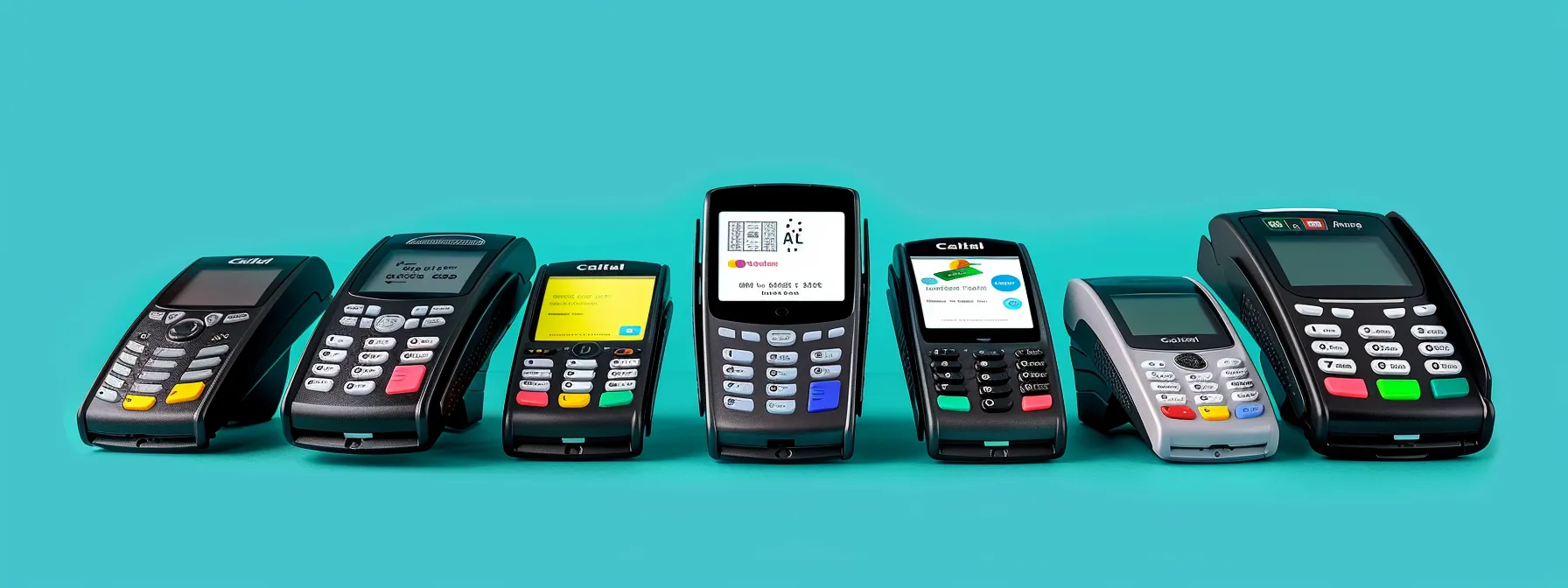Does your business suffer from slow or unreliable payments? This post tackles the issue by outlining key features to consider in a credit card processor, comparing leading providers, and reviewing pricing models. It will assist readers in selecting a payment processor that improves business performance. The article offers clear steps to make an informed decision and addresses common pain points such as processing speed and cost, ensuring readers gain practical insights tailored to their business needs.
Key Takeaways
- businesses benefit from tailored payment processing solutions that boost operational efficiency
- appropriate integrations streamline bookkeeping, transaction speed, and customer communication
- transparent fee structures and clear contract terms support sound financial management
- responsive support and efficient system setups promote consistent growth and performance
The Importance of Choosing the Right Credit Card Processor

Understanding business needs, precise contract terms, and robust emv solutions enable improved operational efficiency while boosting customer experience. Knowledge of these critical factors guides decisions to select ideal payment processors that support specific operations and ensure a seamless customer journey.
Understanding Business Needs
Businesses must address specific needs when selecting credit card processors to ensure proper accessibility, streamlined bookkeeping, and effective evaluation of operational requirements:
| Business Need | Practical Example |
|---|---|
| Accessibility | System integrations that enable easy credit card processing from various devices. |
| Bookkeeping | Automated record keeping that simplifies financial reporting. |
| Evaluation | Assessments of pricing models to choose the best credit card processors for the business. |
Organizations benefit from a clear understanding of their business needs when evaluating credit card processors. A detailed approach to assessing features such as accessibility and bookkeeping support enables informed decisions that optimize performance and meet financial management goals.
The Impact on Customer Experience
The impact on customer experience is clear when businesses select credit card processors with strong analytics and efficient audit functions. Providers like ringcentral and shopify payments offer features that create a smooth checkout process and provide transparent insights into transaction performance, ensuring customers receive the best service possible while maintaining high standards of the payment card industry.
A quality credit card processor improves the speed and security of transactions, leading to a positive customer experience that can build trust and satisfaction. With practical examples from top payment processors, businesses that implement these technologies notice fewer errors and faster resolution of issues, which, in turn, reinforces the commitment to high standards within the payment card industry.
Enhancing Operational Efficiency
Businesses gain improved operational efficiency by selecting a credit card processor that integrates advanced technology for faster transactions and streamlined bookkeeping. The use of barcode scanning and digital wallet options simplifies the shopping process for customers while ensuring secure and reliable performance recognized by organizations like the Better Business Bureau.
Robust systems in credit card processing foster a seamless workflow in managing sales and inventory. Implementing efficient technology, including barcode tracking and digital wallet payment features, helps businesses address challenges and maintain high standards in processing transactions, ultimately supporting better operational outcomes.
Key Features to Consider in Credit Card Processing
Selecting credit card processors requires attention to transaction fees and costs, user-friendly interfaces, strong security features, smooth integration with existing systems, and reliable customer support options. These aspects help control debt, manage lease operations and inventory, and support reputation management, offering practical insights to optimize business performance effectively.
Transaction Fees and Costs
Transaction fees and costs significantly influence overall profitability and digital payment performance, affecting aspects such as electronic funds transfer and customer relationship management; businesses may compare options such as google pay integration to boost credit card rankings and improve user experience:
| Business Factor | Example |
|---|---|
| Digital Integration | Utilizing google pay for seamless digital transactions |
| Operational Efficiency | Optimizing electronic funds transfer processes |
| Customer Experience | Enhancing services to support customer relationship management |
Credit card processor evaluations that include transparent transaction fees empower organizations to make informed financial decisions and optimize operations, ultimately achieving a better experience while maintaining a strong credit card rankings profile across the business landscape.
User-Friendly Interfaces
The design of user-friendly interfaces plays a significant role in the efficiency of merchant services. Efficient platforms incorporate clear visuals and simple navigation features that support tracking accounts payable, managing pos hardware configurations, and promoting smooth wire transfer operations, all while keeping a close watch on price transparency.
Advanced interfaces significantly reduce the learning curve for staff and improve transaction speed. The integration of well-organized dashboards with tools for price monitoring, pos hardware controls, and quick access to merchant services aids organizations in addressing common issues associated with accounts payable and wire transfer processes.
Security Features
Robust security features ensure reliable onboarding and protect client data, strengthening the finance framework that supports smooth operations. This setup improves credit score management while aligning with trusted solutions like braintree and stax:
- Secure transaction processing
- Fraud prevention protocols
- Real-time monitoring of payment activities
Effective security measures minimize risks and help maintain a strong finance profile, ensuring that credit card processors deliver optimal performance for business operations while meeting compliance standards in credit score evaluation and finance management.
Integration With Existing Systems
The integration of payment systems with existing technology is crucial for businesses seeking to streamline operations and improve transaction accuracy. This solution often involves a seamless connection between a verified shopping cart, a reliable card reader, and platforms such as verifone and shopify pos, allowing for a comprehensive comparison of payment options that suits individual business environments.
Expert evaluations show that well-integrated systems enhance efficiency through real-time data sharing between the shopping cart and point-of-sale devices like shopify pos. The consistent performance of a dependable card reader combined with trusted providers such as verifone supports accurate comparisons that help businesses choose the ideal payment processing solution.
Customer Support Options
When evaluating customer support options, businesses can benefit from responsive teams that assist with ios integration, swipesum transactions, and timely troubleshooting to address authentication issues. This level of support is considered a solid investment for organizations seeking smooth operations and efficient processing protocols:
| Feature | Example |
|---|---|
| Mobile Integration | Support for ios and apple pay functionality |
| Transaction Tools | Guidance with swipesum solutions and authentication protocols |
Expert reviews emphasize the importance of clear communication channels and swift assistance for issues related to digital payment systems, ensuring that businesses make informed investments. This reliable support framework enables organizations to maintain strong operational performance and customer satisfaction.
Comparing Top Credit Card Processing Providers

This section presents an overview of key payment processor providers by weighing the pros and cons of each option. It covers topics such as inventory management software, human resources, automated clearing house transfers, menu options, and credit services, alongside case studies of successful implementations to guide effective business decisions.
Overview of Major Players
The analysis of major players in the credit card processing market reveals that providers utilize advanced software to offer reliable data management and analytical tools. This setup allows businesses to utilize feedback from operations while monitoring factors such as termination fee policies, ensuring that each service aligns with financial goals and operational strategy.
Major providers rely on comprehensive data tracking systems that assist businesses in understanding cost structures, including termination fee details and even loan options for expansion. Their software solutions and regular feedback loops offer practical insights that support decision-making, ultimately guiding organizations toward a smooth transition in payment processing operations.
Pros and Cons of Each Option
The analysis of options shows that a merchant account provider may deliver reliable solutions though some alternatives impose an excessive surcharge on certain transactions. Reviewing aspects such as countertop service features and homebase support can reveal both cost-effective and high markup offerings overall:
- Reliable merchant account provider services
- Balanced surcharge policies
- Efficient countertop and homebase configurations
- Reasonable markup practices
Evaluations indicate that benefits like robust integration and automated processes coexist with potential drawbacks related to hidden fees and inconsistent support experiences. This approach provides practical insights that help businesses identify the most suitable payment processor on their list of priorities.
Case Studies of Successful Implementations
Successful case studies illustrate how integrating robust salesforce data with innovative pos software solutions can streamline operations and reduce chargeback risks. Real-world examples demonstrate that businesses have seen improvements in employee benefits and loyalty programs while simplifying the management of transaction disputes.
One notable implementation highlights how a merchant effectively combined advanced pos software and salesforce integration to address multiple challenges:
- Improved tracking of loyalty program rewards
- Streamlined dispute resolutions to minimize chargebacks
- Enhanced employee benefits through efficient data management
This approach allowed the organization to optimize business performance while meeting specific operational needs.
Evaluating Payment Processing Speed and Reliability

Optimizing business performance relies on fast card transactions and reliable systems. This section reviews factors affecting transaction speed, such as payment processing fees and marketing impacts, and assesses downtime to ensure efficiency in card processing services. Insights on discounting and system reliability guide choices that support practical, real-world business operations.
Factors Affecting Transaction Speed
Transaction speed is influenced by various factors that determine how fast a payment solution processes data. The efficiency of the system plays a role in managing accounts receivable, swiftly converting invoice data into processed cash transactions, and this efficiency extends to transactions initiated on a mobile device.
An optimized system ensures that transactions are securely completed without delays, thereby improving overall business performance. This seamless experience supports smooth interactions, whether transmitting invoice details or processing cash payments, which directly benefits businesses by reducing wait times and promoting continuous operations.
Assessing Downtime and Reliability
Assessing downtime and reliability is a crucial step in selecting a payment system that aligns with the performance standards of top merchant service providers such as those featured in forbes and dharma reports. This evaluation provides businesses with insights into the system's ability to maintain continuous operations and offer prompt customer service when challenges occur.
Expert reviews emphasize that a reliable payment system benefits organizations by minimizing downtime and ensuring effective resolutions through proactive customer service. By analyzing system logs and feedback from merchant service providers, businesses can gauge the real-world performance and reliability needed to support seamless transaction processing.
Tailoring Payment Solutions for Different Business Models

This section highlights best practices for retailers, e-commerce platform solutions, and mobile payment considerations. It offers practical insights into selecting a merchant account, utilizing a website builder, and integrating a loyalty program. Readers will also explore a detailed table of contents and customer support strategies that further optimize business performance.
Best Practices for Retailers
Retailers should focus on reliable payment systems and robust business software that simplify transaction processing and support daily operations. An expert review by dharma merchant services shows that clear interfaces and error-free processing improve overall performance and reduce customer challenges:
- Streamlined payment integration
- Accurate transaction processing
- Efficient business software solutions
- Responsive support from dharma merchant services
Efficient systems help retailers manage costs and boost sales by addressing common pain points in payment processing. This approach allows organizations to adopt expert practices that improve the overall customer experience and operational capacity.
Solutions for E-Commerce Platforms
E-commerce platforms benefit from tailored credit card processing solutions that prioritize automation and seamless retail operations. Integrating services like payanywhere and freshbooks enhances scalability and streamlines payment workflows, allowing businesses to manage growth while keeping transaction processes efficient and reliable.
The evaluation of specific payment solutions helps e-commerce platforms overcome common issues related to system integration and speed. Implementing these services, with a focus on automation and scalability, provides real-world insights that support strategic decision-making and optimal operational performance.
Considerations for Mobile Payment Processing
Mobile payment processing requires careful consideration of integration features and hardware compatibility to ensure efficient credit card transactions. Firms benefit by embracing systems that support technologies like mastercard, clover credit card, and modern cash register functionalities, which ultimately boost cash flow and streamline operations. Consider the following key aspects:
- Device compatibility with mobile apps
- Secure transaction methods using mastercard technology
- Reliable credit card transactions with minimal downtime
- Integrated clover credit card solutions for seamless payments
- Efficient cash register connectivity to support smooth cash flow
Evaluating these factors provides practical insights for businesses looking to optimize mobile payment processing. A focus on clear, actionable elements ensures that companies choose a solution that directly addresses operational needs and supports sustainable growth in business performance.
Understanding Pricing Models in Payment Processing

This section evaluates cost models for credit card processing, contrasting flat-rate pricing with interchange-plus. It reviews hidden fees and long-term cost projections, offering insights valuable for businesses using solutions like encryption, Paysafe, Ingenico, mobile app features, and QR code transactions. The following topics guide readers to make informed, cost-effective processing selections.
Flat-Rate Pricing vs. Interchange-Plus
Payment processing companies offer two main pricing models that impact business expense management: flat-rate pricing and interchange-plus. The flat-rate model simplifies fee structures, often appealing to businesses seeking budgeting ease with minimal risk, along with compatibility with free software and accounting software to track expenses efficiently:
- Simplified fee structure
- Easier budget forecasting
- Reduced risk-related uncertainties
Interchange-plus pricing provides transparency and flexibility by breaking down fees into individual components, which assists companies in identifying cost drivers and adjusting strategies. This model supports detailed financial tracking using robust accounting software and offers valuable insights for controlling expense and risk management.
Hidden Fees to Watch Out For
Hidden fees can significantly impact the overall cost of payment processing, and businesses must compare pricing models to avoid surprises. The washington post reports that evaluating these fees helps maintain a solid brand reputation and supports accurate tax planning while navigating the current landscape:
| Fee Type | Example |
|---|---|
| Setup Fee | One-time cost incurred at integration |
| Monthly Maintenance | Recurring fee that affects cash flow |
| Factoring Charges | Additional costs linked to transaction processing |
Focusing on hidden fees allows organizations to assess factoring methods that contribute to a clear financial strategy. A careful review of fee structures not only minimizes unexpected tax implications but also improves the overall performance of the payment processor landscape.
Long-Term Cost Projections
Businesses often evaluate long-term cost projections when selecting credit card processors, focusing on maintaining an efficient mobile payment system and secure tokenization methods. This analysis helps organizations plan for sustainable growth while integrating omnichannel capabilities that include robust pos hardware and effective communication setups using email address verification.
Expert reviews indicate that clear long-term projections support strategic decision-making by highlighting the benefits of advanced mobile payment features and secure tokenization practices. By considering factors such as cost stability and integration with an effective pos system, organizations can address pain points in financial planning and ensure reliable service delivery across omnichannel platforms.
Steps to Make an Informed Decision

Stakeholders provide valuable insights during the selection process. Gathering feedback helps assess credit card payments and credit card fraud risks. Testing and trialing payment processing solutions clarifies card processing fees and overall performance. Finalizing terms and conditions ensures a clear agreement with the chosen payment processing company, reinforcing confidence in card processing decisions.
Gathering Feedback From Stakeholders
Stakeholders provide valuable insights when determining the best option among card processing companies. Input from a lawyer and representatives experienced in software as a service help clarify complex contract terms and assess contactless payment solutions effectively:
- Collect opinions from key decision-makers
- Review experiences with popular systems like square
- Assess feedback on integration ease and security
Gathering feedback from stakeholders strengthens the selection process by offering diverse perspectives that align with operational needs and budget considerations. Practical examples from various card processing companies illustrate how focused evaluations lead to smoother implementations and recommend actionable steps for continuous improvement.
Testing and Trialing Payment Solutions
Evaluating payment solutions through testing and trial periods focuses on practical management aspects that support a smooth transition for any merchant. A controlled test of the debit card functionalities and payment terminal integrations allows businesses to verify the system's reliability and identify potential challenges in real-time.
During the trial phase, entrepreneurship skills come into play by refining operational strategies based on observed performance:
- Review system integration for seamless management
- Assess transaction efficiency involving debit card and payment terminal use
- Collect feedback from stakeholders and frontline staff
This process provides the clarity needed for selecting the right payment solution while mitigating risks and supporting long-term business growth.
Finalizing Terms and Conditions
Finalizing terms and conditions provides clarity on processing fees and ensures that the payment card agreements align with business strategies. This step offers a clear understanding of responsibilities for both the consumer and bank merchant services while confirming that all technical setups, including those available in the app store, meet operational needs.
Negotiating contract details reinforces a smooth collaboration between the business and the payment card provider. Expert insights and practical examples help organizations set clear expectations on processing fees and support structures, ultimately enhancing trust with bank merchant services and guaranteeing adequate consumer protection measures.
Frequently Asked Questions About Credit Card Processing
The section covers key questions that impact business performance. It explains what types of businesses benefit most from a credit card processor, clarifies how long setup takes, and suggests steps for processing issues. Expert insights drawn from flagship merchant services methodology and chase payment solutions are offered, while the website newsletter features additional tips for smooth operations.
What Types of Businesses Benefit Most From a Credit Card Processor?
Small retailers and mid-sized businesses benefit significantly from a quality credit card processor. These organizations experience lower fraud risks and improved communication with customers by integrating efficient pos system solutions and reliable invoice processing capabilities. The processor supports smooth transactions and a secure environment that ultimately boosts customer satisfaction.
Service-oriented businesses and e-commerce ventures also gain from selecting the right credit card processor. They notice improved operational performance as the system minimizes fraud risks, enhances communication channels, and streamlines invoice processing procedures. This efficiency contributes to promoting customer satisfaction and establishes a more robust pos system framework for overall business growth.
How Long Does It Take to Set Up a Payment Processing Account?
The time required to set up a payment processing account varies, with many service providers and payment depot partners offering streamlined onboarding that typically takes just a few days; practitioners note that clear advertising and comprehensive documentation within the ecosystem can expedite the process. A typical setup process may include:
- Initial application and verification
- Integration testing with the processor
- Final approval from service providers
Industry experts emphasize that efficient onboarding procedures and well-coordinated efforts across the ecosystem contribute to faster implementation, ensuring that businesses are up and running quickly while managing their advertising and operational needs effectively.
What Should I Do if I Experience Processing Issues?
When encountering processing issues, businesses should immediately contact their processing companies to clarify the cause and resolve the matter promptly. Expert advice suggests monitoring the impact on sales and ensuring that payment services remain uninterrupted, especially at the point of sale where every transaction counts.
It is advisable for organizations to review system logs and currency conversion settings to determine if discrepancies may have led to delays or errors during transactions. In many instances, direct communication with payment services can help quickly identify the problem, allowing companies to implement corrective measures and maintain smooth operations.
Frequently Asked Questions
What makes a credit card processor suitable for a business?
A credit card processor fits well when it offers reliable payment processing, competitive fees, robust security measures, and supportive merchant services to ensure seamless transactions and efficient integration for business operations.
What features should a payment processor include?
The payment processor should offer fast transaction speeds, robust security measures, seamless integration options with merchant services, and reliable support to help businesses handle payments efficiently.
How do top processors differ in performance?
Top payment processors vary in transaction speed, security measures, and fee structures. Reviews indicate that robust customer service and efficient integration options further set leading services apart, ensuring businesses select options that best fit their operational requirements.
How does processing speed influence transactions?
Payment processing speed improves transaction efficiency by shortening wait times and ensuring prompt authorizations, which boosts operational flow and customer satisfaction.
How do pricing models affect service fees?
Pricing models impact service fees by determining cost structures, affecting transaction percentages versus flat rates or volume discounts, and shaping overall cost-effectiveness for merchants.
Conclusion
Selecting the right credit card processor is crucial for streamlining operations and boosting customer satisfaction. It ensures smooth integration with existing systems and minimizes transaction errors. A well-chosen processor supports reliable data management and cost-effective financial planning. This careful selection plays a key role in driving overall business performance while fostering lasting customer trust.







































